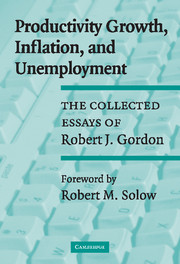Book contents
- Frontmatter
- Contents
- Foreword by Robert M. Solow
- Preface
- Introduction
- PART ONE THE HISTORY, THEORY, AND MEASUREMENT OF PRODUCTIVITY GROWTH
- PART TWO INTERPRETING PRODUCTIVITY FLUCTUATIONS OVER THE BUSINESS CYCLE
- PART THREE THE THEORY OF THE INFLATION-UNEMPLOYMENT TRADEOFF
- PART FOUR EMPIRICAL STUDIES OF INFLATION DYNAMICS IN THE UNITED STATES
- Subject Index
- Author Index
Introduction
Published online by Cambridge University Press: 10 December 2009
- Frontmatter
- Contents
- Foreword by Robert M. Solow
- Preface
- Introduction
- PART ONE THE HISTORY, THEORY, AND MEASUREMENT OF PRODUCTIVITY GROWTH
- PART TWO INTERPRETING PRODUCTIVITY FLUCTUATIONS OVER THE BUSINESS CYCLE
- PART THREE THE THEORY OF THE INFLATION-UNEMPLOYMENT TRADEOFF
- PART FOUR EMPIRICAL STUDIES OF INFLATION DYNAMICS IN THE UNITED STATES
- Subject Index
- Author Index
Summary
Economic growth, inflation, and unemployment are the “big three” topics of macroeconomics. Explicitly embodied in legislation in the United States and other countries are the goals of achieving rapid economic growth, a low rate of inflation, and a low rate of unemployment. When I teach lecture classes on elementary or intermediate macroeconomics to large auditoriums full of fresh-faced undergraduates, the semester begins with simple examples to show how much better off they will be in thirty years with fast rather than slow economic growth, how rapid inflation could erode their savings and that of their parents, and how much easier it will be to find a job for the summer or after graduation if the nation's overall unemployment rate is low rather than high.
THE LAY OF THE LAND
This book, then, is about the big topics of macroeconomics. It is divided into four parts, of which the first is undeniably the most important. Why was American economic growth faster between 1913 and 1972 than before or after? What caused productivity growth to slow down after 1972 and accelerate after 1995? In my view the driving forces of twentieth-century growth were the “great inventions” of the late nineteenth century, especially electricity and the internal combustion engine. The central theme of Part One is the role of these inventions in creating faster growth early in the twentieth century and then, as their influence waned around 1970, slower economic growth.
- Type
- Chapter
- Information
- Productivity Growth, Inflation, and UnemploymentThe Collected Essays of Robert J. Gordon, pp. 1 - 6Publisher: Cambridge University PressPrint publication year: 2003

